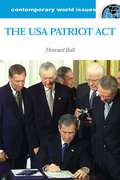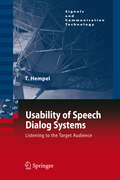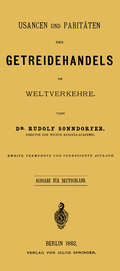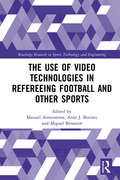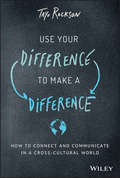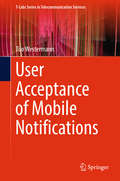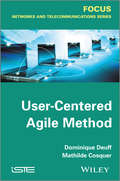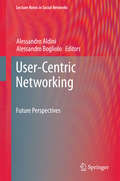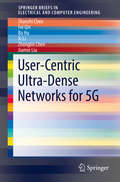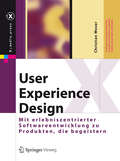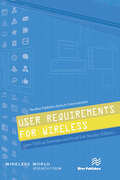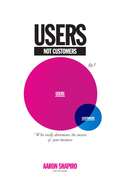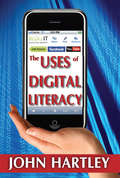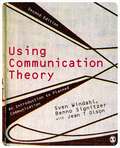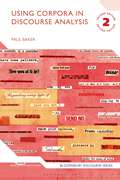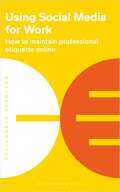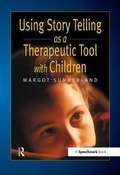- Table View
- List View
The USA Patriot Act: A Reference Handbook (Contemporary World Issues)
by Howard BallThe USA Patriot Act: A Reference Handbook is an in-depth examination of the difficult wartime task of balancing civil liberties against national security.Within weeks of the September 11 terrorist attacks, overwhelming majorities in both houses of Congress passed the USA Patriot Act. The act immediately aroused bitter controversy. Some claim it impermissibly infringes on constitutional rights; others argue it is a necessary tool to ensure the security of the American homeland.Distinguished scholar and prolific author Howard Ball provides the background necessary for a reasoned, historical examination of both positions. He details the threats to America in the last 60 years, emphasizing terrorist acts; examines the temporary surrender of civil rights during past American wars; and uses that history to analyze the USA Patriot Act, both as it exists and as arguments rage over whether to strengthen or weaken the law.
Usability of Speech Dialog Systems: Listening to the Target Audience (Signals and Communication Technology)
by Thomas HempelBefore designing a speech application system, three key questions have to be answered: who will use it, why and how often? This book focuses on these high-level questions and gives a criteria of when and how to design speech systems. After an introduction, the state-of-the-art in modern voice user interfaces is displayed. The book goes on to evolve criteria for designing and evaluating successful voice user interfaces. Trends in this fast growing area are also presented.
Usancen und Paritäten des Getreidehandels im Weltverkehre: Ausgabe für Deutschland
by Rudolf SonndorferThe Use of Video Technologies in Refereeing Football and Other Sports (Routledge Research in Sports Technology and Engineering)
by Manuel Armenteros Anto J. Benitez Miguel Ángel BetancorFor a long time, various different lobbying sectors have claimed that the use of video technology is an effective aid in decision-making. Now the IFAB has taken a historic step in the approval of experiments on the use of video to provide support to football refereeing. The Use of Video Technologies in Refereeing Football and Other Sports analyses the capacity of audio-visual technology from different perspectives to help understand the best implementation of the Video Assistant Referee (VAR) system in football and, more generally, in other sports. This book addresses in-depth interdisciplinary viewpoints on the need and the opportunity of the implementation procedures regarding how to use it, considering that it could lead to very important changes. The book goes on to examine various approaches to the most interesting topics for players, amateurs, coaches, referees and referees coaches. Offering viewpoints from both academics and professionals, this new volume addresses the VAR issue in a multidisciplinary way, analysing the implications of video replay application in football from the perspective of players, coaches, television professionals, referees, amateurs, sports lawyers, media and educators.
The Use of Video Technologies in Refereeing Football and Other Sports (Routledge Research in Sports Technology and Engineering)
by Manuel Armenteros Anto J. Benitez Miguel Ángel BetancorFor a long time, various different lobbying sectors have claimed that the use of video technology is an effective aid in decision-making. Now the IFAB has taken a historic step in the approval of experiments on the use of video to provide support to football refereeing. The Use of Video Technologies in Refereeing Football and Other Sports analyses the capacity of audio-visual technology from different perspectives to help understand the best implementation of the Video Assistant Referee (VAR) system in football and, more generally, in other sports. This book addresses in-depth interdisciplinary viewpoints on the need and the opportunity of the implementation procedures regarding how to use it, considering that it could lead to very important changes. The book goes on to examine various approaches to the most interesting topics for players, amateurs, coaches, referees and referees coaches. Offering viewpoints from both academics and professionals, this new volume addresses the VAR issue in a multidisciplinary way, analysing the implications of video replay application in football from the perspective of players, coaches, television professionals, referees, amateurs, sports lawyers, media and educators.
Use Your Difference to Make a Difference: How to Connect and Communicate in a Cross-Cultural World
by Tayo RocksonBecome more culturally competent in an increasingly diverse world Recent years have seen dramatic changes to several institutions worldwide. Our increasingly interconnected, digitized, and globalized world presents immense opportunities and unique challenges. Modern businesses and schools interact with individuals and organizations from a diverse range of cultural and national backgrounds—increasing the likelihood for miscommunication, errors in strategy, and unintended consequences in the process. This has also spilled into our daily lives and the way we consume information today. Understanding how to navigate these and other pitfalls requires adaptability, nuanced cross-cultural communication, and effective conflict resolution. Use Your Difference to Make a Difference provides readers with a skills-based, actionable plan that transforms differences into agents of inclusiveness, connection, and mutual understanding. This innovative and timely guide illustrates how to leverage differences to move beyond unconscious biases, manage a culturally-diverse workplace, create an environment for more tolerant schooling environments, more trusted media, communicate across borders, find and retain diverse talent, and bridge the gap between working locally and expanding globally. Expert guidance on a comprehensive range of topics—teamwork, leadership styles, information sharing, delegation, supervision, giving and receiving feedback, coaching and motivation, recruiting, managing suppliers and customers, and more—helps you manage the essential aspects of international relationships and cultural awareness. This valuable resource contains the indispensable knowledge required to: Develop self-awareness needed to be a cross-cultural communicator Develop content, messaging techniques, marketing plans, and business strategies that translate across cultural borders Help your employees to better understand and collaborate with clients and colleagues from different backgrounds Help teachers build safe environments for students to be themselves Strengthen cross-cultural competencies in yourself, your team, and your entire organization Understand the cultural, economic, and political factors surrounding our world Use Your Difference to Make a Difference is a must-have resource for any educator, parent, leader, manager, or team member of an organization that interacts with co-workers and customers from diverse cultural backgrounds.
Use Your Difference to Make a Difference: How to Connect and Communicate in a Cross-Cultural World
by Tayo RocksonBecome more culturally competent in an increasingly diverse world Recent years have seen dramatic changes to several institutions worldwide. Our increasingly interconnected, digitized, and globalized world presents immense opportunities and unique challenges. Modern businesses and schools interact with individuals and organizations from a diverse range of cultural and national backgrounds—increasing the likelihood for miscommunication, errors in strategy, and unintended consequences in the process. This has also spilled into our daily lives and the way we consume information today. Understanding how to navigate these and other pitfalls requires adaptability, nuanced cross-cultural communication, and effective conflict resolution. Use Your Difference to Make a Difference provides readers with a skills-based, actionable plan that transforms differences into agents of inclusiveness, connection, and mutual understanding. This innovative and timely guide illustrates how to leverage differences to move beyond unconscious biases, manage a culturally-diverse workplace, create an environment for more tolerant schooling environments, more trusted media, communicate across borders, find and retain diverse talent, and bridge the gap between working locally and expanding globally. Expert guidance on a comprehensive range of topics—teamwork, leadership styles, information sharing, delegation, supervision, giving and receiving feedback, coaching and motivation, recruiting, managing suppliers and customers, and more—helps you manage the essential aspects of international relationships and cultural awareness. This valuable resource contains the indispensable knowledge required to: Develop self-awareness needed to be a cross-cultural communicator Develop content, messaging techniques, marketing plans, and business strategies that translate across cultural borders Help your employees to better understand and collaborate with clients and colleagues from different backgrounds Help teachers build safe environments for students to be themselves Strengthen cross-cultural competencies in yourself, your team, and your entire organization Understand the cultural, economic, and political factors surrounding our world Use Your Difference to Make a Difference is a must-have resource for any educator, parent, leader, manager, or team member of an organization that interacts with co-workers and customers from diverse cultural backgrounds.
User Acceptance of Mobile Notifications (T-Labs Series in Telecommunication Services)
by Tilo WestermannThis book presents an alternative approach to studying smartphone-app user notifications. It starts with insights into user acceptance of mobile notifications in order to provide tools to support users in managing these. It extends previous research by investigating factors that influence users’ perception of notifications and proposes tools addressing the shortcomings of current systems. It presents a technical framework and testbed as an approach for evaluating the usage of mobile applications and notifications, and then discusses a series of studies based on this framework that investigate factors influencing users’ perceptions of mobile notifications. Lastly, a set of design guidelines for the usage of mobile notifications is derived that can be employed to support users in handling notifications on smartphones.
User-Centered Agile Method
by Dominique Deuff Mathilde CosquerAgile development methods began to emerge around 20 years ago. However, it was not until the early 2000s that they began to be widely used in industry. This growth was often due to the advent of Internet services requiring faster cycles of development in order to heighten the rate at which an ever-greater number of functionalities were made available. In parallel, user-centered design (UCD) methods were also becoming more and more widely used: hence, user-centered design and agile methods were bound to cross paths, at least in the telecoms industry! During this period, in the field of telecommunications, the explosion in the number of connected terminals, Web applications, new use environments (particularly in a domestic setting), etc., meant it was crucial to gain a fuller understanding of users’ requirements and better evaluate the relevance and acceptance of services’ attempts to cater for these requirements. Thus the user-centered agile method, as proposed in this book, aims to mutually integrate two existing methods: user-centered design – as used by ergonomists – and the agile Scrum method – as used by developers. The user testing method is also covered. Analyzing work on this subject spanning the past 10 years, the authors also provide an assessment of the feedback on the user-centered agile method. The method described in this book has been based on all these sources. It is a framework relying on the logic introduced by Scrum, i.e. a framework based on project management. The method proposed is seen as an extension of Scrum which is “centered on humans” because of the integration of user-centered design and user-testing. Therefore the description of the user-centered agile method is based on the basics of the agile Scrum method and uses its terminology and elements. As well as descriptive elements of the user-centered agile method, practical examples of how to implement it are also provided. Contents 1. Introduction. 2. Intrioduction to the Methods Employed. 3. Sources for this Work. 4. Description of The User-Centered Agile Method. 5. Case Studies. About the Authors Dominique Deuff worked at the National Institute of Informatics in Japan for 2½ years before coming back to France in June 2006 and joining Orange Labs France Telecom as a developer in a Scrum team. In 2008, she graduated with a Master’s degree in ergonomics and has since then been applying her new skills to various projects at Orange Labs Lannion. Mathilde Cosquer joined Orange Labs as an ergonomist after completing her PhD on the question of transparency of technical devices from the user’s point of view. She has taken part in the design and evaluation of numerous innovating services, but over the past four years, she has been more particularly involved in projects of interpersonal communication services.
User-Centered Agile Method
by Dominique Deuff Mathilde CosquerAgile development methods began to emerge around 20 years ago. However, it was not until the early 2000s that they began to be widely used in industry. This growth was often due to the advent of Internet services requiring faster cycles of development in order to heighten the rate at which an ever-greater number of functionalities were made available. In parallel, user-centered design (UCD) methods were also becoming more and more widely used: hence, user-centered design and agile methods were bound to cross paths, at least in the telecoms industry! During this period, in the field of telecommunications, the explosion in the number of connected terminals, Web applications, new use environments (particularly in a domestic setting), etc., meant it was crucial to gain a fuller understanding of users’ requirements and better evaluate the relevance and acceptance of services’ attempts to cater for these requirements. Thus the user-centered agile method, as proposed in this book, aims to mutually integrate two existing methods: user-centered design – as used by ergonomists – and the agile Scrum method – as used by developers. The user testing method is also covered. Analyzing work on this subject spanning the past 10 years, the authors also provide an assessment of the feedback on the user-centered agile method. The method described in this book has been based on all these sources. It is a framework relying on the logic introduced by Scrum, i.e. a framework based on project management. The method proposed is seen as an extension of Scrum which is “centered on humans” because of the integration of user-centered design and user-testing. Therefore the description of the user-centered agile method is based on the basics of the agile Scrum method and uses its terminology and elements. As well as descriptive elements of the user-centered agile method, practical examples of how to implement it are also provided. Contents 1. Introduction. 2. Intrioduction to the Methods Employed. 3. Sources for this Work. 4. Description of The User-Centered Agile Method. 5. Case Studies. About the Authors Dominique Deuff worked at the National Institute of Informatics in Japan for 2½ years before coming back to France in June 2006 and joining Orange Labs France Telecom as a developer in a Scrum team. In 2008, she graduated with a Master’s degree in ergonomics and has since then been applying her new skills to various projects at Orange Labs Lannion. Mathilde Cosquer joined Orange Labs as an ergonomist after completing her PhD on the question of transparency of technical devices from the user’s point of view. She has taken part in the design and evaluation of numerous innovating services, but over the past four years, she has been more particularly involved in projects of interpersonal communication services.
User-Centric Networking: Future Perspectives (Lecture Notes in Social Networks)
by Alessandro Aldini Alessandro BoglioloThis work represents a milestone for the "ULOOP User-centric Wireless Local Loop" project funded by the EU IST Seventh Framework Programme.ULOOP is focused on the robust, secure, and autonomic deployment of user-centric wireless networks. Contributions by ULOOP partners as well as invited tutorials by international experts in the field. The expected impact is to increase awareness to user-centric networking in terms, e.g., of business opportunities and quality of experience, and to present adequate technology to sustain the growth of user-friendly wireless architectures.Throughout the last 3 years, ULOOP has developed enabling technologies for user-centricity in wireless networks, with particular emphasis on social trust management, cooperation incentives, community building, mobility estimation, and resource management.This work will be of interest to researchers, policymakers, operators, vendors, and end-users interested in the current and future directions of user-centric access networks.
User-Centric Ultra-Dense Networks for 5G (SpringerBriefs in Electrical and Computer Engineering)
by Shanzhi Chen Fei Qin Bo Hu Xi Li Zhonglin Chen Jiamin LiuThis is the first book to introduce UUDN for 5G, including the concept, challenges, architecture and key technologies. The new network architecture based on “de-cellular” and “user-centric” is proposed with three kinds of decoupling: user plane and control plane decoupling from radio access, control and transmission decoupling from network, local service and network service decoupling. Key characteristics of UUDN are provided, including four aspects: Intelligent network knows user, Moving network follows user, Dynamic network serves user, and Secured network protects user. Four promising technology directions are discussed in detail, including dynamic APs grouping (DAPGing) method, intelligent networking, advanced interference management and user-centric security. The authors also include a UUDN solution, illustrated with numerology and evaluation results as a practical example. Finally, further research directions of UUDN are analyzed. This book gives an overall introduction of UUDN for people who are interested and just begin their study, as well as some suggestions on further research for experts involved in academic, industrial and standardization activities on relative fields.
User Experience Design: Mit erlebniszentrierter Softwareentwicklung zu Produkten, die begeistern (X.media.press)
by Christian MoserFunktionalität allein reicht bei Internet- oder Desktop-Anwendungen heute nicht aus, das Benutzererlebnis ist zunehmend ein Schlüsselfaktor für den Markterfolg. Ein positives Benutzererlebnis entsteht aber nur dann, wenn im Entwicklungsprozess Benutzeranalyse, Verständnis für das Business und Design perfekt aufeinander abgestimmt sind. Das Buch bietet einen kompakten Einstieg in die Thematik und führt durch den gesamten Prozess: vom Design und der Businessanalyse bis zur Produkteinführung. Relevante Methoden werden einfach und verständlich erklärt.
User Requirements for Wireless
by Lene Sørensen Knud Erik SkoubyIn most IT system development processes, the identification or elicitation of user requirements is recognized as a key building block. In practice, the identification of user needs and wants is a challenge and inadequate or faulty identifications in this step of an IT system development can cause huge problems with the final product. The elicitation of user requirements as such changes according to age groups;, to gender,; to cultural settings,; and into time; and experience in the use of the system/software. User requirements, therefore, cannot be used between projects, IT systems, and different software. That makes the elicitation of user requirements an inherent part of any software development project and a resourceful activity as well. This book provides insights to the process of identifying user requirements and to different types by describing varying case studies in which technologies or software has been developed. A variety of user requirements are provided illustrating the effect of changing the targeted user group with respect to age,; to the context and the different technologies or software as well as to the difference in viewpoint on ways of involving users in the elicitation process. Cases and user requirement elements discussed in the book include: • User requirements elicitation processes for children, construction workers, and farmers• User requirements for personalized services of a broadcast company• Variations in user involvement• Practical elements of user involvement and requirements elicitation• Usable security requirements for design of privacy.
User Requirements for Wireless
by Lene Tolstrup Sørensen Knud Erik SkoubyIn most IT system development processes, the identification or elicitation of user requirements is recognized as a key building block. In practice, the identification of user needs and wants is a challenge and inadequate or faulty identifications in this step of an IT system development can cause huge problems with the final product. The elicitation of user requirements as such changes according to age groups;, to gender,; to cultural settings,; and into time; and experience in the use of the system/software. User requirements, therefore, cannot be used between projects, IT systems, and different software. That makes the elicitation of user requirements an inherent part of any software development project and a resourceful activity as well. This book provides insights to the process of identifying user requirements and to different types by describing varying case studies in which technologies or software has been developed. A variety of user requirements are provided illustrating the effect of changing the targeted user group with respect to age,; to the context and the different technologies or software as well as to the difference in viewpoint on ways of involving users in the elicitation process. Cases and user requirement elements discussed in the book include: • User requirements elicitation processes for children, construction workers, and farmers• User requirements for personalized services of a broadcast company• Variations in user involvement• Practical elements of user involvement and requirements elicitation• Usable security requirements for design of privacy.
Users Not Customers: Who Really Determines the Success of Your Business
by Aaron ShapiroBoardroom conversations are adapting to a new and brutal reality; there is no such thing as an offline business. And if you don't embrace digital, you'll be out of business altogether.Blockbuster, AOL, Yahoo and Borders were all unstoppable, but they didn't see the new economic order coming. Google, Facebook, Groupon, and Twitter barely existed at the turn of the millennium, but are now rocketing ahead.Aaron Shapiro is CEO of HUGE, the leading digital agency which builds and operates websites that handle 150 million users a month and bring in $1.2 billion annually for their clients. That's the GDP of a small country. He thinks constantly about the most pressing issue in business today: how can businesses can use digital to thrive?Shapiro has studied what the businesses succeeding today have in common, and in Users First, Customers Second, he teaches us to recognise that it's not just customers who interact with the digital version of our organisations.The businesses who are now roaring ahead put the interests and the digital experience of all of their users - employees, business partners, media and anyone else who interacts with you through digital channels - ahead of everything else, including their paying customers.In a world were we are all users you have a choice: you can be sure that people are using your digital ecosystem, or you can be irrelevant.
The Uses of Digital Literacy
by John HartleyAt the heart of this book lies a reappraisal of humanities research and its use in understanding the conditions of a consumer-led society. This is an open, investigative, critical, scientific task as well as an opportunity to engage with creative enterprise and culture. Now that every user is a publisher, consumption needs to be rethought as action not behavior, and media consumption as a mode of literacy.Online social networks and participatory media are often still ignored by professionals, denounced in the press and banned in schools. But the potential of digital literacy should not be underestimated. Fifty years after Richard Hoggart's pioneering The Uses of Literacy reshaped the educational response to popular culture, John Hartley extends Hoggart's argument into digital media. Media evolution has made possible the realism of the modern age journalism, the novel and science not to mention mass entertainment on a global scale.Hartley reassesses the historical and global context, commercial and cultural dynamics and the potential of popular productivity through analysis of the use of digital media in various domains, including creative industries, digital storytelling, YouTube, journalism, and mediated fashion. Encouraging mass participation in the evolutionary growth of knowledge, The Uses of Digital Literacy shows how today's teenage fad may become tomorrow's scientific method. Hartley claims the time has come for education to catch up with entertainment and for the professionals to learn from popular culture. This book will stimulate the imagination and stir further research.
The Uses of Digital Literacy (Creative Economy + Innovation Culture Ser.)
by John HartleyAt the heart of this book lies a reappraisal of humanities research and its use in understanding the conditions of a consumer-led society. This is an open, investigative, critical, scientific task as well as an opportunity to engage with creative enterprise and culture. Now that every user is a publisher, consumption needs to be rethought as action not behavior, and media consumption as a mode of literacy.Online social networks and participatory media are often still ignored by professionals, denounced in the press and banned in schools. But the potential of digital literacy should not be underestimated. Fifty years after Richard Hoggart's pioneering The Uses of Literacy reshaped the educational response to popular culture, John Hartley extends Hoggart's argument into digital media. Media evolution has made possible the realism of the modern age journalism, the novel and science not to mention mass entertainment on a global scale.Hartley reassesses the historical and global context, commercial and cultural dynamics and the potential of popular productivity through analysis of the use of digital media in various domains, including creative industries, digital storytelling, YouTube, journalism, and mediated fashion. Encouraging mass participation in the evolutionary growth of knowledge, The Uses of Digital Literacy shows how today's teenage fad may become tomorrow's scientific method. Hartley claims the time has come for education to catch up with entertainment and for the professionals to learn from popular culture. This book will stimulate the imagination and stir further research.
Using Communication Theory: An Introduction to Planned Communication (PDF)
by Dr Benno Signitzer Dr Sven Windahl Jean T Olson"Using Communication Theory was a rarity in bridging the gap between ideas and practice. It was itself a model of good communication and in its second, revised edition, it is still a most reliable and accessible guide to the lessons that communication theory and research offer to practitioners, especially in planning for change. " - Denis McQuail, Professor Emeritus, University of Amsterdam "Using Communication Theory has become a classic in the education of communication. It is the comprehensive and self-evident source for theories and models, forming the base for the study of professions requiring communication planning. " - Lars#65533;ke Larsson, #65533;rebro University What does theory have to do with the practice of communication? Communication planning is used daily by thousands of people: public relations practitioners, technical writers, information campaigners, advertising professionals, organization consultants, educators, health communicators and more. Without a solid understanding of communication theory, practitioners have difficulty getting their messages heard. The second edition of this best-selling textbook has been updated with the student firmly in mind. With new learning features that directly engage with the practical side of theory, students will: Practice what they learn with activities and exercises. Apply their own experiences to theory through prompts to reflection. Consolidate their learning with highlighted definitions and lists of key terms. Take it further with boxed excerpts from classic texts. Showing how theories relate directly to the planning and experience of effective communication, Using Communication Theory - 2nd Edition provides indispensable insights into the practical nature of communication theory. In today's landscape of communication overload, this book remains an essential, authoritative guide for both students and practitioners.
Using Communication Theory: An Introduction to Planned Communication
by Dr Benno Signitzer Dr Sven Windahl Jean T Olson"Using Communication Theory was a rarity in bridging the gap between ideas and practice. It was itself a model of good communication and in its second, revised edition, it is still a most reliable and accessible guide to the lessons that communication theory and research offer to practitioners, especially in planning for change." - Denis McQuail, Professor Emeritus, University of Amsterdam "Using Communication Theory has become a classic in the education of communication. It is the comprehensive and self-evident source for theories and models, forming the base for the study of professions requiring communication planning." - Larsåke Larsson, Örebro University What does theory have to do with the practice of communication? Communication planning is used daily by thousands of people: public relations practitioners, technical writers, information campaigners, advertising professionals, organization consultants, educators, health communicators and more. Without a solid understanding of communication theory, practitioners have difficulty getting their messages heard. The second edition of this best-selling textbook has been updated with the student firmly in mind. With new learning features that directly engage with the practical side of theory, students will: Practice what they learn with activities and exercises. Apply their own experiences to theory through prompts to reflection. Consolidate their learning with highlighted definitions and lists of key terms. Take it further with boxed excerpts from classic texts. Showing how theories relate directly to the planning and experience of effective communication, Using Communication Theory - 2nd Edition provides indispensable insights into the practical nature of communication theory. In today’s landscape of communication overload, this book remains an essential, authoritative guide for both students and practitioners.
Using Corpora in Discourse Analysis (Bloomsbury Discourse)
by Paul BakerHow can you carry out discourse analysis using corpus linguistics? What research questions should I ask? Which methods should you use and when? What is a collocational network or a key cluster? Introducing the major techniques, methods and tools for corpus-assisted analysis of discourse, this book answers these questions and more, showing readers how to best use corpora in their analyses of discourse. Using carefully tailored case studies, each chapter is devoted to a central technique, including frequency, concordancing and keywords, going step by step through the process of applying different analytical procedures. Introducing a wide range of different corpora, from holiday brochures to political debates, the book considers the key debates and latest advances in the field. Fully revised and updated, this new edition includes:- A new chapter on how to conduct research projects in corpus-based discourse analysis- Completely rewritten chapters on collocation and advanced techniques, using a corpus of jihadist propaganda texts and covering topics such as social media and visual analysis- Coverage of major tools, including CQPweb, AntConc, Sketch Engine and #LancsBox- Discussion of newer techniques including the derivation of lockwords and the comparison of multiple data sets for diachronic analysisWith exercises, discussion questions and suggested further readings in each chapter, this book is an excellent guide to using corpus linguistics techniques to carry out discourse analysis.
Using Corpora in Discourse Analysis (Bloomsbury Discourse)
by Paul BakerHow can you carry out discourse analysis using corpus linguistics? What research questions should I ask? Which methods should you use and when? What is a collocational network or a key cluster? Introducing the major techniques, methods and tools for corpus-assisted analysis of discourse, this book answers these questions and more, showing readers how to best use corpora in their analyses of discourse. Using carefully tailored case studies, each chapter is devoted to a central technique, including frequency, concordancing and keywords, going step by step through the process of applying different analytical procedures. Introducing a wide range of different corpora, from holiday brochures to political debates, the book considers the key debates and latest advances in the field. Fully revised and updated, this new edition includes:- A new chapter on how to conduct research projects in corpus-based discourse analysis- Completely rewritten chapters on collocation and advanced techniques, using a corpus of jihadist propaganda texts and covering topics such as social media and visual analysis- Coverage of major tools, including CQPweb, AntConc, Sketch Engine and #LancsBox- Discussion of newer techniques including the derivation of lockwords and the comparison of multiple data sets for diachronic analysisWith exercises, discussion questions and suggested further readings in each chapter, this book is an excellent guide to using corpus linguistics techniques to carry out discourse analysis.
Using Social Media for work: How to maintain professional etiquette online (Business Essentials)
by Bloomsbury PublishingEssential reading for anyone who has to work with social media in a professional capacity, from using networking sites to marketing their businesses or employers.Many people use social media every day - and it can be a vital tool in professional life. Whether you're polishing an online CV, contributing to a chat group relating to your industry sector, or using Instagram to highlight goods and services, the professional face you present needs to be strategically different to the 'social' posts that you may make outside of work. Using Social Media at Work is an easy to read, pocket-sized guide that can be dipped into for advice, tips and guidance - perfect for reading in a lunch break or on a commute. It is the ultimate etiquette guide for anyone nervous about using social media in professional settings, including: top tips, common mistakes and advice on how to avoid them, summaries of key points, and lists of the best sources of further help.
Using Social Media for work: How to maintain professional etiquette online (Business Essentials)
by Bloomsbury PublishingEssential reading for anyone who has to work with social media in a professional capacity, from using networking sites to marketing their businesses or employers.Many people use social media every day - and it can be a vital tool in professional life. Whether you're polishing an online CV, contributing to a chat group relating to your industry sector, or using Instagram to highlight goods and services, the professional face you present needs to be strategically different to the 'social' posts that you may make outside of work. Using Social Media at Work is an easy to read, pocket-sized guide that can be dipped into for advice, tips and guidance - perfect for reading in a lunch break or on a commute. It is the ultimate etiquette guide for anyone nervous about using social media in professional settings, including: top tips, common mistakes and advice on how to avoid them, summaries of key points, and lists of the best sources of further help.
Using Story Telling as a Therapeutic Tool with Children (Helping Children With Feelings Ser.)
by Margot SunderlandThis practical handbook begins with the philosophy and psychology underpinning the therapeutic value of story telling. It shows how to use story telling as a therapeutic tool with children and how to make an effective response when a child tells a story to you. It is an essential accompaniment to the "Helping Children with Feelings" series and covers issues such as: Why story telling is such a good way of helping children with their feelings? What resources you may need in a story-telling session? How to construct your own therapeutic story for a child? What to do when children tell stories to you? Things to do and say when working with a child's story.
